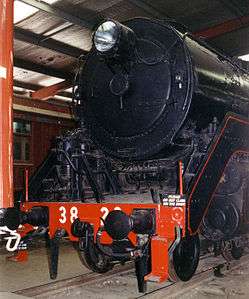3820
3820 (pronounced Thirty-eight twenty) is a 4-6-2 steam locomotive operated by the New South Wales Government Railways between 1947 and 1970. It has been preserved by the Trainworks Railway Museum, Thirlmere.
| 3820 | |||||||||||||||||||||||||||||||||||||||||
|---|---|---|---|---|---|---|---|---|---|---|---|---|---|---|---|---|---|---|---|---|---|---|---|---|---|---|---|---|---|---|---|---|---|---|---|---|---|---|---|---|---|
 3820 at the New South Wales Rail Transport Museum in 1991 | |||||||||||||||||||||||||||||||||||||||||
| |||||||||||||||||||||||||||||||||||||||||
| |||||||||||||||||||||||||||||||||||||||||
| |||||||||||||||||||||||||||||||||||||||||
| |||||||||||||||||||||||||||||||||||||||||
Construction
3820 was built in 1947 by the New South Wales Government Railways', Eveleigh Railway Workshops as the 20th of 30 38 class locomotives built to haul express trains. The first five were built by Clyde Engineering to a streamlined design, whilst the later 25 locomotives in the class were built by the NSWGR's Eveleigh and Cardiff Locomotive Workshops and were unstreamlined.
Construction was delayed mostly due to material shortages during World War II. It was at various times allocated to Eveleigh, Enfield, Lithgow and Broadmeadow Locomotive Depots.[1]
During the rundown of steam operation in New South Wales, 3820 had the distinction of some lasts:[1][2]
- May 1964: hauled official last steam hauled Riverina Express in May 1964
- May 1964: last official revenue steam duty on the Main South line beyond Goulburn
- 13 December 1968: was the last C38 class to be overhauled whilst in regular service, both being overhauled together at Cardiff Locomotive Workshops
- 29 December 1970: worked the official last steam hauled express passenger train in Australia, the Newcastle Flyer
- 29 December 1970: last 38 class in revenue service when withdrawn
Preservation
Upon withdrawal, 3820 was placed in the custody of the New South Wales Rail Transport Museum and based at Enfield Locomotive Depot operating excursion trains including a journey to Melbourne with 3801, and the Last Run which it triple headed with 3203 and 3526 to Tarana on 21 April 1973 before the Public Transport Commission banned main line steam operation.[1][2]
3820 was steamed on 1 January 1975, to act as a standby for 3801, which was used to haul fundraising trains for Cyclone Tracy survivors.[2] In June 1975, it hauled 4001 and 2419 to Thirlmere when the New South Wales Rail Transport Museum relocated.[3] It was then withdrawn. In 1980 it was hauled to Central station for display at an event commemorating 125 years of rail operations in New South Wales.[1]
3820 is painted black with red lining whereas 3801 and 3830 wear a green livery. 3820 is considered to be of historic significance as the only remaining 38 class locomotive that remains in the same condition it was in at time of withdrawal and as such retains a significant amount of evidence for research purposes.[2]
References
- Locomotive, Steam 3820 NSW Environment & Heritage
- "NSWRTM - 3820". New South Wales Rail Transport Museum. Archived from the original on 20 August 2006. Retrieved 4 February 2010.
- "Museum on the Move" Roundhouse June 1976 page 16